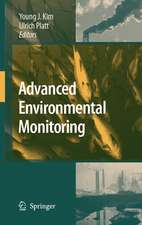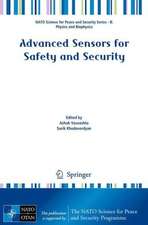Towards the Monitoring of Dumped Munitions Threat (MODUM): A Study of Chemical Munitions Dumpsites in the Baltic Sea: NATO Science for Peace and Security Series C: Environmental Security
Editat de Jacek Bełdowski, Robert Been, Eyup Kuntay Turmusen Limba Engleză Paperback – 19 sep 2017
This book describes the creation of a monitoring network, which can provide information about the exact locations and the environmental threats posed by chemical weapons (CW) dumpsites in the Baltic Sea region, using autonomous underwater vehicles (AUVs) and remotely operated underwater vehicles (ROVs), and utilising the existing research vessels of NATO partner institutions as launching platforms.
The dumping operations occurred shortly after World War II and included captured German munitions. Operations with munitions from the Soviet occupation zone were performed by the Soviet Navy, operations with munitions from British and American occupation zones were performed in areas outside of the Baltic Sea (Skagerrak Strait); the fate of munitions from the French occupation zone was never reported. Due to difficult legal status of these munitions, and high costs of remediation and retrieval, removal of these weapons from the bottom of the Baltic Sea seems unlikely in theforeseeable future. These dumped chemical weapons pose an actual environmental and security hazard in the Baltic Sea Region. Nowadays, with more and more industrial activities being performed in the Baltic Sea Area, the threat level is rising.
The AUV survey is based on the IVER2 platform by OceanServer, equipped with Klein 3500 side-scan sonar. The identification phase utilises several ROVs, equipped with targeting sonars, acoustic cameras capable of penetrating turbid bottom waters up to 20m, and visual HD cameras. A novel sediment sampling system, based on a camera and sonar equipped cassette sampler, has been developed to obtain surface sediments. The test phase described consists of a survey phase, which will locate the actual objects concerned, and a monitoring phase, which will concentrate on the collection of environmental data close to the objects concerned.
The dumping operations occurred shortly after World War II and included captured German munitions. Operations with munitions from the Soviet occupation zone were performed by the Soviet Navy, operations with munitions from British and American occupation zones were performed in areas outside of the Baltic Sea (Skagerrak Strait); the fate of munitions from the French occupation zone was never reported. Due to difficult legal status of these munitions, and high costs of remediation and retrieval, removal of these weapons from the bottom of the Baltic Sea seems unlikely in theforeseeable future. These dumped chemical weapons pose an actual environmental and security hazard in the Baltic Sea Region. Nowadays, with more and more industrial activities being performed in the Baltic Sea Area, the threat level is rising.
The AUV survey is based on the IVER2 platform by OceanServer, equipped with Klein 3500 side-scan sonar. The identification phase utilises several ROVs, equipped with targeting sonars, acoustic cameras capable of penetrating turbid bottom waters up to 20m, and visual HD cameras. A novel sediment sampling system, based on a camera and sonar equipped cassette sampler, has been developed to obtain surface sediments. The test phase described consists of a survey phase, which will locate the actual objects concerned, and a monitoring phase, which will concentrate on the collection of environmental data close to the objects concerned.
| Toate formatele și edițiile | Preț | Express |
|---|---|---|
| Paperback (1) | 553.60 lei 38-45 zile | |
| SPRINGER NETHERLANDS – 19 sep 2017 | 553.60 lei 38-45 zile | |
| Hardback (1) | 562.91 lei 38-45 zile | |
| SPRINGER NETHERLANDS – 19 sep 2017 | 562.91 lei 38-45 zile |
Din seria NATO Science for Peace and Security Series C: Environmental Security
- 18%
 Preț: 1106.00 lei
Preț: 1106.00 lei - 15%
 Preț: 659.70 lei
Preț: 659.70 lei - 18%
 Preț: 999.60 lei
Preț: 999.60 lei - 18%
 Preț: 1221.07 lei
Preț: 1221.07 lei - 18%
 Preț: 1220.75 lei
Preț: 1220.75 lei - 18%
 Preț: 940.39 lei
Preț: 940.39 lei - 18%
 Preț: 1216.78 lei
Preț: 1216.78 lei - 18%
 Preț: 1232.71 lei
Preț: 1232.71 lei - 18%
 Preț: 1818.02 lei
Preț: 1818.02 lei - 18%
 Preț: 1833.95 lei
Preț: 1833.95 lei - 18%
 Preț: 1231.47 lei
Preț: 1231.47 lei - 18%
 Preț: 942.44 lei
Preț: 942.44 lei - 18%
 Preț: 1218.06 lei
Preț: 1218.06 lei - 18%
 Preț: 1383.00 lei
Preț: 1383.00 lei - 15%
 Preț: 664.29 lei
Preț: 664.29 lei - 18%
 Preț: 1220.88 lei
Preț: 1220.88 lei - 24%
 Preț: 1040.01 lei
Preț: 1040.01 lei - 18%
 Preț: 1222.80 lei
Preț: 1222.80 lei - 18%
 Preț: 1220.75 lei
Preț: 1220.75 lei - 18%
 Preț: 1224.85 lei
Preț: 1224.85 lei - 18%
 Preț: 1224.85 lei
Preț: 1224.85 lei - 18%
 Preț: 1224.68 lei
Preț: 1224.68 lei - 18%
 Preț: 963.15 lei
Preț: 963.15 lei - 18%
 Preț: 1229.10 lei
Preț: 1229.10 lei - 18%
 Preț: 1222.49 lei
Preț: 1222.49 lei - 18%
 Preț: 1223.74 lei
Preț: 1223.74 lei - 18%
 Preț: 1213.65 lei
Preț: 1213.65 lei - 18%
 Preț: 956.33 lei
Preț: 956.33 lei - 18%
 Preț: 1235.43 lei
Preț: 1235.43 lei - 18%
 Preț: 940.39 lei
Preț: 940.39 lei - 18%
 Preț: 1210.63 lei
Preț: 1210.63 lei - 18%
 Preț: 1219.63 lei
Preț: 1219.63 lei - 18%
 Preț: 1225.48 lei
Preț: 1225.48 lei - 18%
 Preț: 1228.75 lei
Preț: 1228.75 lei - 18%
 Preț: 1228.62 lei
Preț: 1228.62 lei - 18%
 Preț: 1222.94 lei
Preț: 1222.94 lei - 18%
 Preț: 962.98 lei
Preț: 962.98 lei - 18%
 Preț: 1218.06 lei
Preț: 1218.06 lei - 15%
 Preț: 643.99 lei
Preț: 643.99 lei - 18%
 Preț: 1220.12 lei
Preț: 1220.12 lei - 18%
 Preț: 1233.52 lei
Preț: 1233.52 lei - 18%
 Preț: 946.24 lei
Preț: 946.24 lei - 18%
 Preț: 1218.21 lei
Preț: 1218.21 lei - 18%
 Preț: 953.65 lei
Preț: 953.65 lei
Preț: 553.60 lei
Preț vechi: 692.00 lei
-20% Nou
Puncte Express: 830
Preț estimativ în valută:
105.93€ • 110.60$ • 87.67£
105.93€ • 110.60$ • 87.67£
Carte tipărită la comandă
Livrare economică 31 martie-07 aprilie
Preluare comenzi: 021 569.72.76
Specificații
ISBN-13: 9789402411614
ISBN-10: 9402411615
Pagini: 210
Ilustrații: XVII, 240 p. 101 illus. in color.
Dimensiuni: 155 x 235 mm
Ediția:1st ed. 2018
Editura: SPRINGER NETHERLANDS
Colecția Springer
Seria NATO Science for Peace and Security Series C: Environmental Security
Locul publicării:Dordrecht, Netherlands
ISBN-10: 9402411615
Pagini: 210
Ilustrații: XVII, 240 p. 101 illus. in color.
Dimensiuni: 155 x 235 mm
Ediția:1st ed. 2018
Editura: SPRINGER NETHERLANDS
Colecția Springer
Seria NATO Science for Peace and Security Series C: Environmental Security
Locul publicării:Dordrecht, Netherlands
Textul de pe ultima copertă
This book describes the creation of a monitoring network, which can provide information about the exact locations and the environmental threats posed by chemical weapons (CW) dumpsites in the Baltic Sea region, using autonomous underwater vehicles (AUVs) and remotely operated underwater vehicles (ROVs), and utilising the existing research vessels of NATO partner institutions as launching platforms.
The dumping operations occurred shortly after World War II and included captured German munitions. Operations with munitions from the Soviet occupation zone were performed by the Soviet Navy, operations with munitions from British and American occupation zones were performed in areas outside of the Baltic Sea (Skagerrak Strait); the fate of munitions from the French occupation zone was never reported. Due to difficult legal status of these munitions, and high costs of remediation and retrieval, removal of these weapons from the bottom of the Baltic Sea seems unlikely in the foreseeable future. These dumped chemical weapons pose an actual environmental and security hazard in the Baltic Sea Region. Nowadays, with more and more industrial activities being performed in the Baltic Sea Area, the threat level is rising.
The AUV survey is based on the IVER2 platform by OceanServer, equipped with Klein 3500 side-scan sonar. The identification phase utilises several ROVs, equipped with targeting sonars, acoustic cameras capable of penetrating turbid bottom waters up to 20m, and visual HD cameras. A novel sediment sampling system, based on a camera and sonar equipped cassette sampler, has been developed to obtain surface sediments. The test phase described consists of a survey phase, which will locate the actual objects concerned, and a monitoring phase, which will concentrate on the collection of environmental data close to the objects concerned.
The dumping operations occurred shortly after World War II and included captured German munitions. Operations with munitions from the Soviet occupation zone were performed by the Soviet Navy, operations with munitions from British and American occupation zones were performed in areas outside of the Baltic Sea (Skagerrak Strait); the fate of munitions from the French occupation zone was never reported. Due to difficult legal status of these munitions, and high costs of remediation and retrieval, removal of these weapons from the bottom of the Baltic Sea seems unlikely in the foreseeable future. These dumped chemical weapons pose an actual environmental and security hazard in the Baltic Sea Region. Nowadays, with more and more industrial activities being performed in the Baltic Sea Area, the threat level is rising.
The AUV survey is based on the IVER2 platform by OceanServer, equipped with Klein 3500 side-scan sonar. The identification phase utilises several ROVs, equipped with targeting sonars, acoustic cameras capable of penetrating turbid bottom waters up to 20m, and visual HD cameras. A novel sediment sampling system, based on a camera and sonar equipped cassette sampler, has been developed to obtain surface sediments. The test phase described consists of a survey phase, which will locate the actual objects concerned, and a monitoring phase, which will concentrate on the collection of environmental data close to the objects concerned.


























